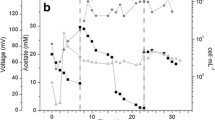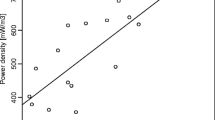Abstract
Microbial fuel cell (MFC) anode communities often reveal just a few genera, but it is not known to what extent less abundant bacteria could be important for improving performance. We examined the microbial community in an MFC fed with formic acid for more than 1 year and determined using 16S rRNA gene cloning and fluorescent in situ hybridization that members of the Paracoccus genus comprised most (~30%) of the anode community. A Paracoccus isolate obtained from this biofilm (Paracoccus denitrificans strain PS-1) produced only 5.6 mW/m2, whereas the original mixed culture produced up to 10 mW/m2. Despite the absence of any Shewanella species in the clone library, we isolated a strain of Shewanella putrefaciens (strain PS-2) from the same biofilm capable of producing a higher-power density (17.4 mW/m2) than the mixed culture, although voltage generation was variable. Our results suggest that the numerical abundance of microorganisms in biofilms cannot be assumed a priori to correlate to capacities of these predominant species for high-power production. Detailed screening of bacterial biofilms may therefore be needed to identify important strains capable of high-power generation for specific substrates.





Similar content being viewed by others
References
Amann R (1995) In situ identification of micro-organisms by whole cell hybridization with rRNA-targeted nucleic acid probes. In: Akkermans ADL, van Elsas JD, de Bruijn FJ (eds) Molecular microbial ecology manual. Kluwer Academic, Dordrecht, pp 1–15
Balch WE, Fox GE, Magrum LJ, Woese CR, Wolfe RS (1979) Methanogens: reevaluation of a unique biological group. Microbiol Rev 43(2):260–296
Biffinger JC, Byrd JN, Dudley BL, Ringeisen BR (2008) Oxygen exposure promotes fuel diversity for Shewanella oneidensis microbial fuel cells. Biosens Bioelectron 23(6):820–826
Bond DR, Lovley DR (2003) Electricity production by Geobacter sulfurreducens attached to electrodes. Appl Environ Microbiol 69(3):1548–1555
Caccavo F Jr, Lonergan DJ, Lovley DR, Davis M, Stolz JF, McInerney MJ (1994) Geobacter sulfurreducens sp. nov., a hydrogen- and acetate-oxidizing dissimilatory metal-reducing microorganism. Appl Environ Microbiol 60(10):3752–3759
Call D, Logan BE (2008) Hydrogen production in a single chamber microbial electrolysis cell lacking a membrane. Environ Sci Technol 42(9):3401–3406
Call DF, Wagner R, Logan BE (2009) Hydrogen production by Geobacter species and a mixed consortium in a microbial electrolysis cell. Appl Environ Microbiol 75(24):7579–7587
Cervantes FJ, Duong-Dac T, Ivanova AE, Roest K, Akkermans AD, Lettinga G, Field JA (2003) Selective enrichment of Geobacter sulfurreducens from anaerobic granular sludge with quinones as terminal electron acceptors. Biotechnol Lett 25(1):39–45
Chae KJ, Choi MJ, Lee JW, Kim KY, Kim IS (2009) Effect of different substrates on the performance, bacterial diversity, and bacterial viability in microbial fuel cells. Bioresour Technol 100(14):3518–3525
Cheng S, Logan BE (2007) Ammonia treatment of carbon cloth anodes to enhance power generation of microbial fuel cells. Electrochem commun 9:492–496
Cheng S, Liu H, Logan BE (2006) Increased performance of single-chamber microbial fuel cells using an improved cathode structure. Electrochem Commun 8(8):489–494
Coates JD, Phillips EJ, Lonergan DJ, Jenter H, Lovley DR (1996) Isolation of Geobacter species from diverse sedimentary environments. Appl Environ Microbiol 62(5):1531–1536
Dolfing J, Jiang B, Henstra AM, Stams AJ, Plugge CM (2008) Syntrophic growth on formate: a new microbial niche in anoxic environments. Appl Environ Microbiol 74(19):6126–6131
Harms N, van Spanning RJ (1991) C1 metabolism in Paracoccus denitrificans: genetics of Paracoccus denitrificans. J Bioenerg Biomembr 23(2):187–210
Huggett MJ, Crocetti GR, Kjelleberg S, Steinberg PD (2008) Recruitment of the sea urchin Heliocidaris erythrogramma and the distribution and abundance of inducing bacteria in the field. Aquat Microb Ecol 53(2):161–171
Jacobs MA, Alwood A, Thaipisuttikul I, Spencer D, Haugen E, Ernst S, Will O, Kaul R, Raymond C, Levy R, Chun-Rong L, Guenthner D, Bovee D, Olson MV, Manoil C (2003) Comprehensive transposon mutant library of Pseudomonas aeruginosa. Proc Natl Acad Sci U S A 100(24):14339–14344
Kelly DP, Rainey FA, Wood AP (2006) The genus Paracoccus. Prokaryotes 5:232–249
Kiely PD, Rader G, Regan JM and Logan BE (2010) Long-term cathode performance and the microbial communities that develop microbial fuel cells fed different fermentation endproducts. Bioresour Technol doi:10.1016/j.biortech.2010.05.017
Kumar R, Singh S, Singh OV (2008) Bioconversion of lignocellulosic biomass: biochemical and molecular perspectives. J Ind Microbiol Biotechnol 35(5):377–391
Lalaurette E, Thammannagowda S, Mohagheghi A, Maness P-C, Logan BE (2009) Hydrogen production from cellulose in a two-stage process combining fermentation and electrohydrogenesis. Int J Hydrogen Energy 34(15):6201–6210
Liu B-F, Ren N-Q, Tang J, Ding J, Liu W-Z, Xu J-F, Cao G-L, Guo W-Q, Xie G-J (2010) Bio-hydrogen production by mixed culture of photo- and dark-fermentation bacteria. Int J Hydrogen Energy 35(7):2858–2862
Logan B, Cheng S, Watson V, Estadt G (2007) Graphite fiber brush anodes for increased power production in air-cathode microbial fuel cells. Environ Sci Technol 41(9):3341–3346
Lovley DR, Phillips EJ, Lonergan DJ (1989) Hydrogen and formate oxidation coupled to dissimilatory reduction of iron or manganese by Alteromonas putrefaciens. Appl Environ Microbiol 55(3):700–706
Lovley DR, Giovannoni SJ, White DC, Champine JE, Phillips EJ, Gorby YA, Goodwin S (1993) Geobacter metallireducens gen. nov. sp. nov., a microorganism capable of coupling the complete oxidation of organic compounds to the reduction of iron and other metals. Arch Microbiol 159(4):336–344
Mazoch J, Tesarik R, Sedlacek V, Kucera I, Turanek J (2004) Isolation and biochemical characterization of two soluble iron(III) reductases from Paracoccus denitrificans. Eur J Biochem 271(3):553–562
Milliken CE, May HD (2007) Sustained generation of electricity by the spore-forming, Gram-positive, Desulfitobacterium hafniense strain DCB2. Appl Microbiol Biotechnol 73(5):1180–1189
Morris MJ, Jin S (2009) Influence of NO3 and SO4 on power generation from microbial fuel cells. Chem Eng J 153:127–130
Myers CR, Myers JM (1992) Localization of cytochromes to the outer membrane of anaerobically grown Shewanella putrefaciens MR-1. J Bacteriol 174(11):3429–3438
Neef A, Zaglauer A, Meier H, Amann R, Lemmer H, Schleifer KH (1996) Population analysis in a denitrifying sand filter: conventional and in situ identification of Paracoccus spp. in methanol-fed biofilms. Appl Environ Microbiol 62(12):4329–4339
Oh SE, Kim JR, Joo J, Logan BE (2009) Effects of applied voltages and dissolved oxygen on sustained power generation by microbial fuel cells. Water Sci Technol 60(5):1311–1317
Pant D, Van Bogaert G, Diels L, Vanbroekhoven K (2010) A review of the substrates used in microbial fuel cells (MFCs) for sustainable energy production. Bioresour Technol 101(6):1533–1543
Parameswaran P, Torres CI, Lee H-S, Krajmalnik-Brown R, Rittmann B (2009a) Syntrophic interactions among anode respiring bacteria (ARB) and non-ARB in a biofilm anode: electron balances. Biotechnol Bioeng 103(3):513–522
Parameswaran P, Zhang H, Torres CI, Rittmann BE, Krajmalnik-Brown R (2009b) Microbial community structure in a biofilm anode fed with a fermentable substrate: the significance of hydrogen scavengers. Biotechnol Bioeng 105(1):69–78
Pavlekovic M, Schmid MC, Schmider-Poignee N, Spring S, Pilhofer M, Gaul T, Fiandaca M, Löffler FE, Jetten M, Schleifer KH, Lee NM (2009) Optimization of three FISH procedures for in situ detection of anaerobic ammonium oxidizing bacteria in biological wastewater treatment. J Microbiol Methods 78(2):119–126
Phuc TH, Beomsoek T, Chang IS (2008) Performance and bacterial consortium of microbial fuel cell fed with formate. Energy Fuels 22:164–168
Rabaey K, Van de Sompel K, Maignien L, Boon N, Aelterman P, Clauwaert P, De Schamphelaire L, Pham HT, Vermeulen J, Verhaege M, Lens P, Verstraete W (2006) Microbial fuel cells for sulfide removal. Environ Sci Technol 40(17):5218–5224
Rainey FA, Kelly DP, Stackebrandt E, Burghardt J, Hiraishi A, Katayama Y, Wood AP (1999) A re-evaluation of the taxonomy of Paracoccus denitrificans and a proposal for the combination Paracoccus pantotrophus comb. nov. Int J Syst Bacteriol 49(Pt 2):645–651
Ren N, Wang A, Cao G, Xu J, Gao L (2010) Bioconversion of lignocellulosic biomass to hydrogen: potential and challenges. Biotechnol Adv 27(6):1051–1060
Richter H, Lanthier M, Nevin KP, Lovley DR (2007) Lack of electricity production by Pelobacter carbinolicus indicates that the capacity for Fe(III) oxide reduction does not necessarily confer electron transfer ability to fuel cell anodes. Appl Environ Microbiol 73(16):5347–5353
Stams AJ, Plugge CM (2009) Electron transfer in syntrophic communities of anaerobic bacteria and archaea. Nat Rev Microbiol 7(8):568–577
Sukkasem C, Xu S, Park S, Boonsawang P, Liu H (2008) Effect of nitrate on the performance of single chamber air cathode microbial fuel cells. Water Res 42(19):4743–4750
Tamura K, Dudley J, Nei M, Kumar S (2007) MEGA4: Molecular Evolutionary Genetics Analysis (MEGA) software version 4.0. Mol Biol Evol 24(8):1596–1599
Thauer RK, Jungermann K, Decker K (1977) Energy conservation in chemotrophic anaerobic bacteria. Bacteriol Rev 41(1):100–180
von Canstein H, Ogawa J, Shimizu S, Lloyd JR (2008) Secretion of flavins by Shewanella species and their role in extracellular electron transfer. Appl Environ Microbiol 74(3):615–623
Watson VJ, Logan BE (2009) Power production in MFCs inoculated with Shewanella oneidensis MR-1 or mixed cultures. Biotechnol Bioeng 105(3):489–498
Winker S, Woese CR (1991) A definition of the domains Archaea, Bacteria and Eucarya in terms of small subunit ribosomal RNA characteristics. Syst Appl Microbiol 14(4):305–310
Xing D, Cheng S, Logan BE, Regan JM (2009) Isolation of the exoelectrogenic denitrifying bacterium Comamonas denitrificans based on dilution to extinction. Appl Microbiol Biotechnol 85(5):1575–1587
Zhang X, Cheng S, Wang X, Huang X, Logan BE (2009) Separator characteristics for increasing performance of microbial fuel cells. Environ Sci Technol 43(18):7148–7152
Acknowledgments
This research was supported by Award KUS-I1-003-13 from the King Abdullah University of Science and Technology (KAUST) and the National Renewable Energy Laboratory (RFH-7-77623-01).
Author information
Authors and Affiliations
Corresponding author
Electronic supplementary material
Below is the link to the electronic supplementary material.
Supplementary information
(PDF 994 kb)
Rights and permissions
About this article
Cite this article
Kiely, P.D., Call, D.F., Yates, M.D. et al. Anodic biofilms in microbial fuel cells harbor low numbers of higher-power-producing bacteria than abundant genera. Appl Microbiol Biotechnol 88, 371–380 (2010). https://doi.org/10.1007/s00253-010-2757-2
Received:
Revised:
Accepted:
Published:
Issue Date:
DOI: https://doi.org/10.1007/s00253-010-2757-2




